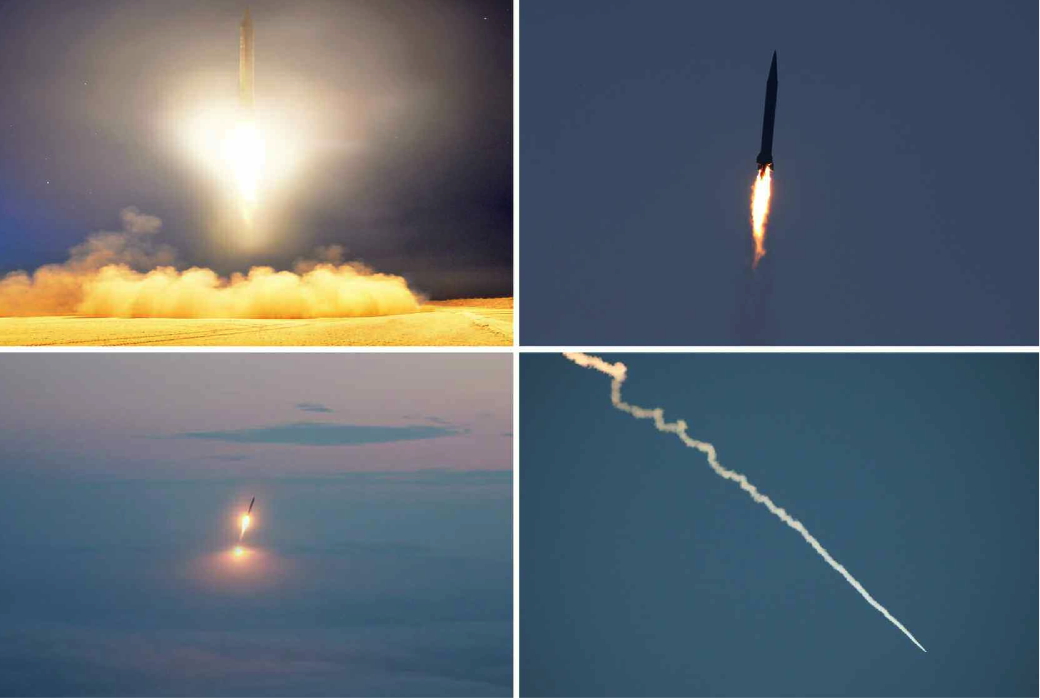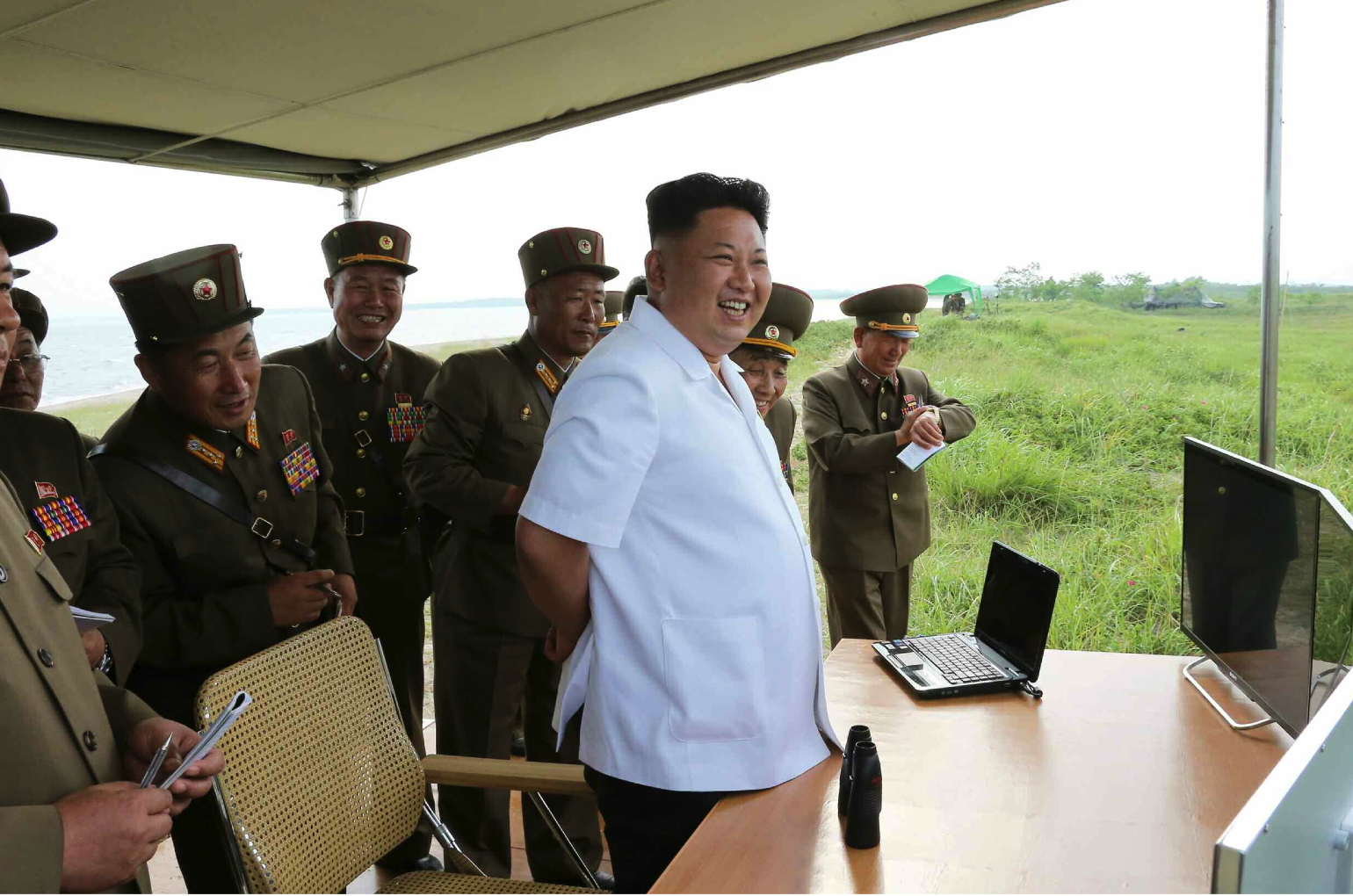Kim Jong Un Supervises Missile Test Firings (updated and revised June 29)
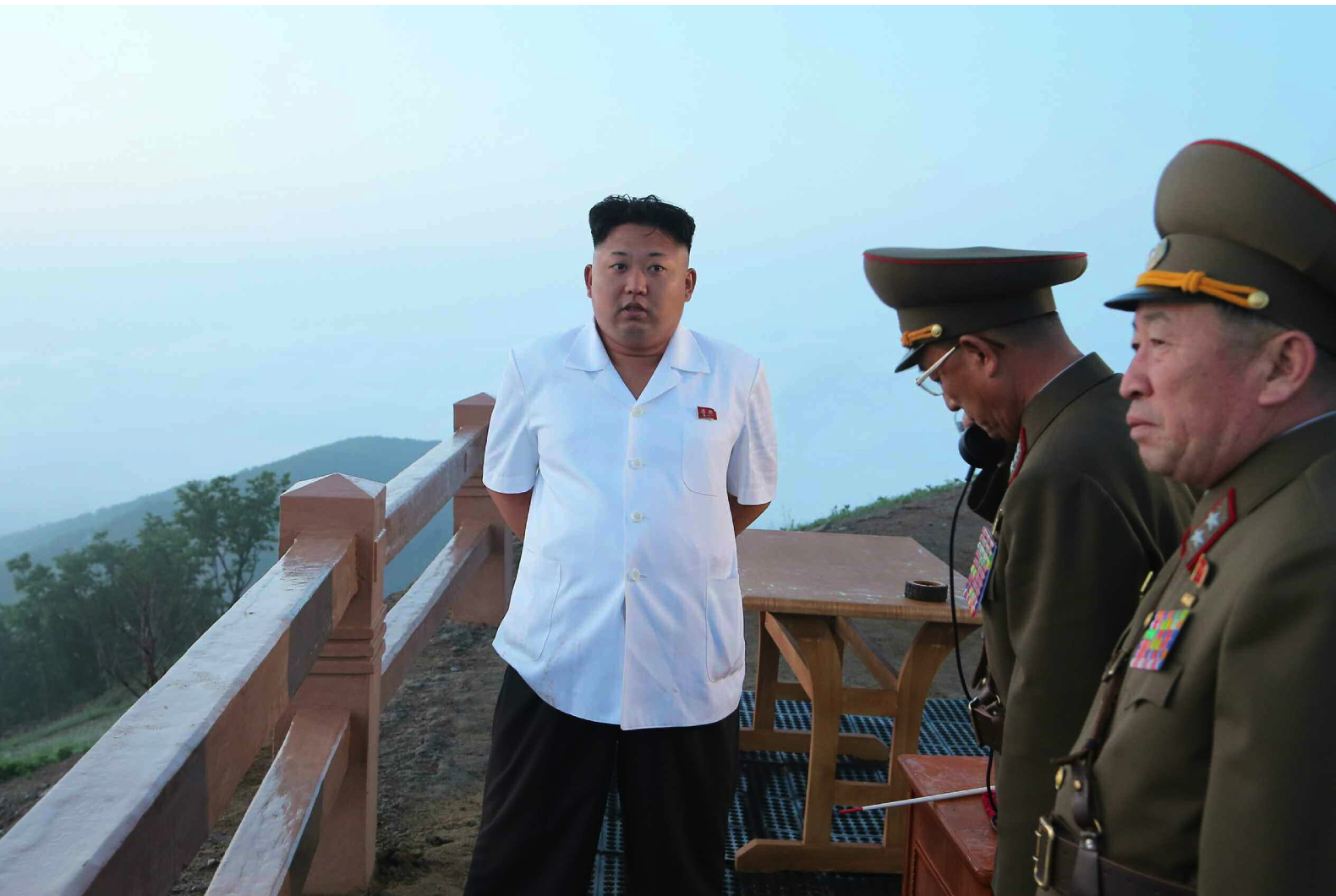
Kim Jong Un at a rocket drill by the KPA Strategic Rocket Forces on or around 29 June 2014 (Photo: Rodong Sinmun).
DPRK state media reported on 29 June (Sunday) that Kim Jong Un (Kim Cho’ng-u’n) attended and supervised the tactical missile firing drill conducted by the Korean People’s Army [KPA] Strategic Rocket Forces. Attending the test firing of the two short-range Scud missiles was VMar Hwang Pyong So (Director of the KPA General Political Department). At the drill site KJU was joined by Commander of the KPA Strategic Rocket Force Col. Gen. Kim Rak Gyom and other senior command staff of the SRF. KJU’s last observed appearance was his visit to the recently constructed Kalma Foodstuffs Factory.
After receiving a briefing on the rocket drill, Kim Jong Un ordered that the drill commence. KCNA reported that the drill “smoothly conducted on the basis of a scientific calculation of the whole course of the rocket firing and the scrupulous security check and search for flight orbit and targeted waters” and “had no slight impact not only on the regional peace and security but on international navigation order and ecological environment.” After the drill, KJU “expressed great satisfaction over the successful firing of tactical rockets” and participated in a commemorative photo-op with KPA service member and officer participants in the drill.

Kim Jong Un observes a “tactical rocket firing” drill of the KPA Strategic Rocket Force on 29 June 2014 near Wo’nsan, Kangwo’n Province (Photo: Rodong Sinmun).
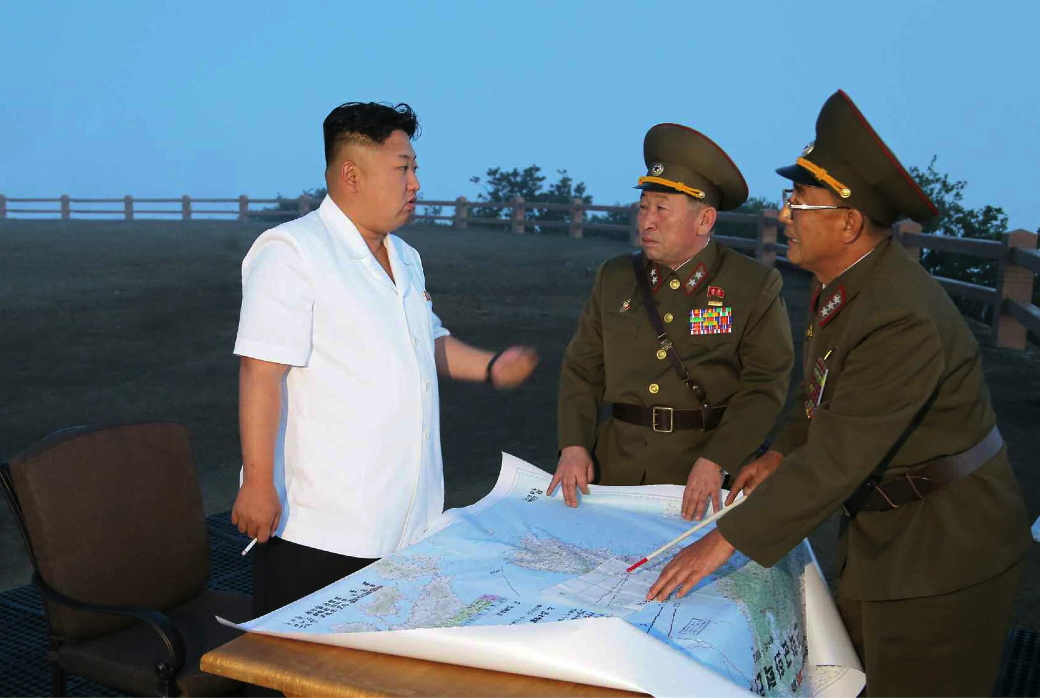
Kim Jong Un talks with KPA Strategic Rocket Force commander Col. Gen. Kim Rak Gyom (R) and the SRF’s vice commander (C) (Photo: Rodong Sinmun).
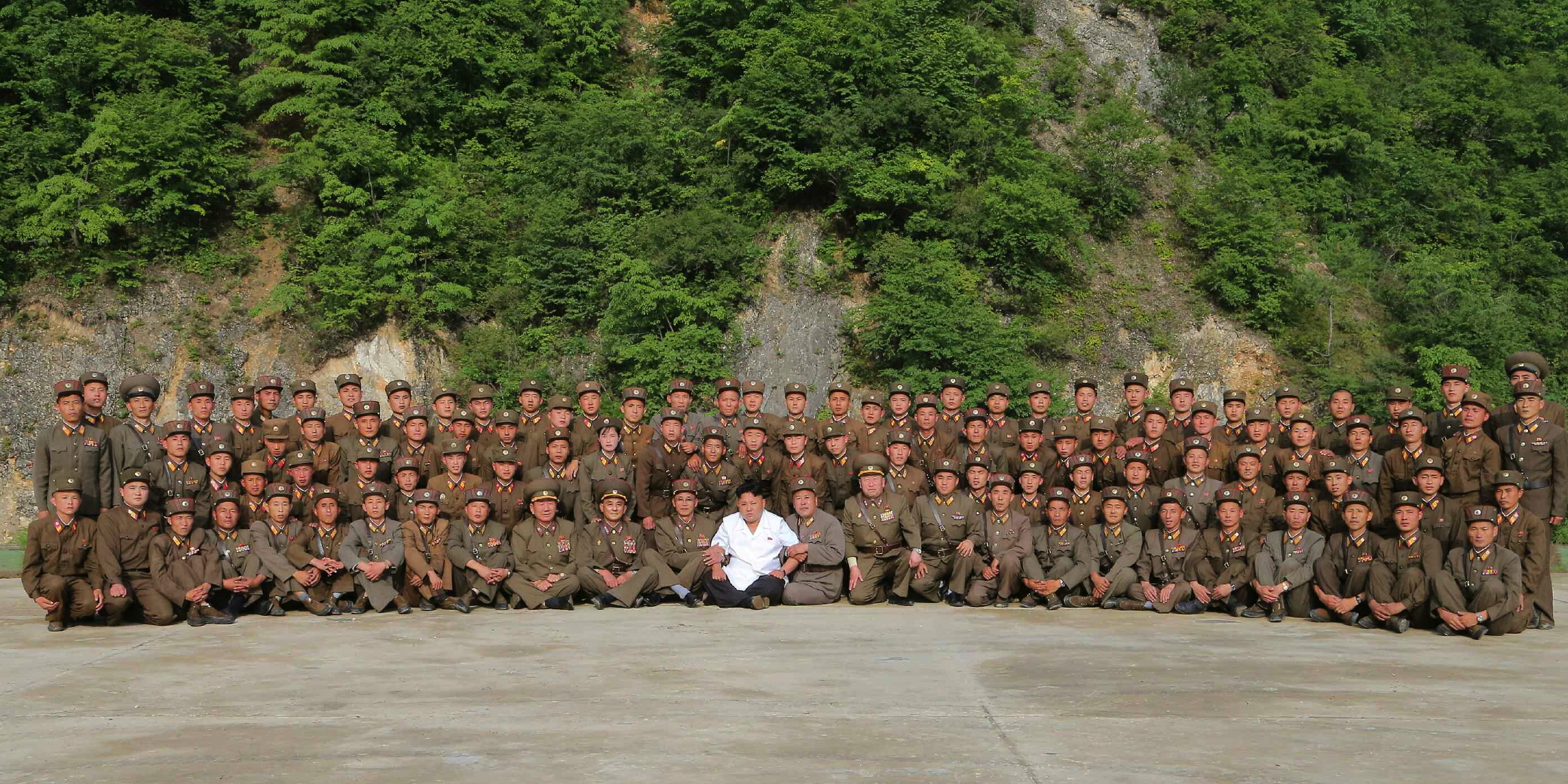
Kim Jong Un poses for a commemorative photo with participants in the KPA Strategic Rocket Force’s 29 June 2014 drill that used two short-range Scud missiles (Photo: Rodong Sinmun).

Kim Jong Un poses for a commemorative photo with service members and officers of the KPA Strategic Rocket Force after their participation in a drill on 29 June 2014 (Photo: Rodong Sinmun).
According to KCNA, Kim Jong Un said that “the peaceful environment dearest to the DPRK people can neither be provided by someone nor can be bartered for anything” and “that as durable peace can be protected only when one is so strong that nobody dares provoke one and it can be guaranteed by one’s own strength, it is necessary to put the biggest spurs to bolstering up the self-defensive deterrent of the KPA in every way to protect the security and peace of the country and firmly defend the gains of the revolution.” He “underscored the need to round off the combat readiness of the strategic force so that no aggressors may recklessly dare threaten and infringe upon the cause, sovereignty and vital rights of the DPRK and to further develop and perfect Chuch’e-oriented rocket science and technology and firing methods.” Kim Jong Un also “expressed great expectation and belief that the service personnel of the strategic force would keep themselves fully ready to fire the highly effective ballistic rockets any moment on high alert as required by the prevailing situation and the developing revolution and thus foil the reckless acts of the U.S. imperialists and their followers who are steeped in evil repugnancy and pursue inveterate hostile policy toward the DPRK and provide a firm guarantee for the building of a thriving socialist nation.”
The test firing of the Scuds (or “ballistic rockets”) was observed around 5:00 KST on 29 June, the DPRK test fired two short-range Scuds, again from a site near Wo’nsan.
On 27 June (Friday) that KJU attended the test firing of tactical guided missiles. Attending this test firing with him were VMar Hwang Pyong So, Gen. Pyon In Son (Director of the KPA General Staff Operations Bureau), Col. Gen. Pak Jong Chon (Vice Chief of the KPA General Staff) and Hong Yong Chil (Deputy [vice] Director of the Workers’ Party of Korea [WPK] Machine-Building Industry Department). KJU’s last observed appearance at that time was a visit to the construction of the Pyongyang Baby Home and Orphanage.
After being briefed on on the “the tactical and technological information of the newly developed guided missiles” Kim Jong ordered that the test firing commence. KCNA reported that the “test-fire proved that the tactical guided weapons didn’t have an inch of deviation in their scientific and technological performance” and that the test was “another shining success made by scientists in the field of national defense and workers in the field of munitions industry in their efforts to implement the WPK’s policy of manufacturing high-precision, lighter, automatic and intelligent weapons and equipment.” The missile test “helped the KPA get the master key to putting all strike means including short-, medium- and long-range guided weapons on ultra-precision basis of the world level and opened a bright prospect for maximizing their striking accuracy and power.” The “test-fire at a time when the U.S. and the south Korean puppet regime and all other allied forces are going extremely reckless in the moves to isolate and stifle the DPRK and unleash a war of aggression marked a significant event in bolstering up the defense capability for self-defense” and “greatly encourages the service personnel and people of the DPRK.”

Kim Jong Un speaks to KPA and WPK munitions industry officials after a missile test flight held on or around 26 June 2014 (Photo: Rodong Sinmun).
According to KCNA, Kim Jong Un “expressed great satisfaction over the results of the test-fire” and remarked that “officials and workers in the fields of national defense science and munitions industry would manufacture more ultra-precision tactical guided weapons capable of taking the decisive initiative in any operation and battle of the modern warfare through accurate preemptive strikes, always bearing in mind the expectations of the party and the people.” KJU also “advanced new tasks to be fulfilled by the field of national defense science and technology.”
The test firing of the missiles was first observed at around 17:00 KST on 26 June (Thursday). An unnamed official of the ROK Joint Chiefs of Staff [JCS] speculated to Yonhap that “their range is some 190 kilometers, and we are now looking into exactly what type of rockets North Korea fired” and noted that the KPA’s KN-09 300 mm MRL has “a similar range.” The JCS official also said the “300-millimeter launcher is known to have an up to 160 kilometer range” and that “as of now, it is yet to be confirmed if the North enhanced its capacity.”
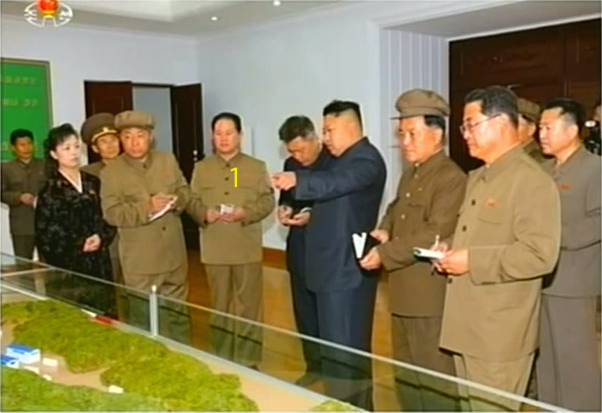
Kim Jong Un visits the January 18 General Machinery Plant in South P’yo’ngan Province in May 2014. Also in attendance is Hong Yong Chil (1) a leading party official in the development and production of missiles and WMDs (Photo: KCTV).

The January 18 General Machinery Plant is a leading producer of missile engines. The plant was tasked by the central leadership in May 2014 to boost its production of missile engines for the DPRK’s short- and medium-range missiles (Photo: Google image).
This latest pair of missile tests is probably linked to a missile production policy initiated by Kim Jong Un in May 2014. According to both DPRK and ROK sources, KJU ordered an increase in the production of short- and medium-range missiles. On 14 May, DPRK state media reported that Kim Jong Un visited the January 18 General Machinery Plant in South P’yo’ngan Province. During his visit he said that the “plant should put the production processes on a CNC and unmanned basis in order to boost the production of highly efficient machine products needed by various fields of the national economy and achieve successes in the work for developing new varieties of products” and he “set the goals to be attained by the plant in the near future and promised with loving care to solve all the problems arising in updating it including the provision of all latest equipment needed for it.” He also opined that the plant is “the eldest brother-like plant and a heart-like plant in developing the nation’s machine-building industry and the Party attaches great importance to this plant.I came here today to turn the plant into a model one, a pivotal and core one representing the machine plants of our country.”
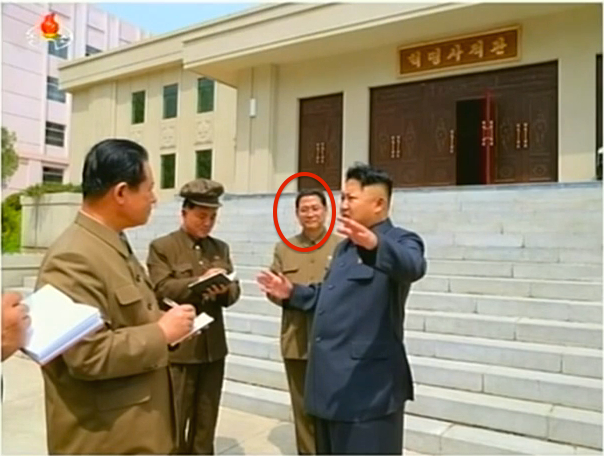
Pak Thae Song (Pak T’ae-so’ng), circled, deputy director of the WPK Organization Guidance Department, attends Kim Jong Un’s May 2014 visit to the January 18 General Machinery Plant (Photo: KCTV).
The plan to renovate and upgrade the January 18 General Machinery Plant is a key aspect of KJU’s missile production policy because it will manufacture missile engines for the DPRK’s eventual new inventory of short- and medium-range missiles. Additional missile production is also expected to be carried out at other industrial facilities in South P’yo’ngan Province. Underscoring the importance of South P’yo’ngan Province in DPRK missile production, Kim Jong Un has tapped one of his close aides to monitor the progress of manufacturing as well as the renovation of the January 18 General Machinery Plant. In late May, WPK Organization Guidance Department deputy [vice] director Pak Thae Song (Pak T’ae-so’ng) was appointed Chief Secretary of the South P’yo’ngan WPK Provincial Committee. In this position, Pak will ensure that relevant factory managers and functionaries in South P’yo’gan comply with KJU’s instructions on missile production.
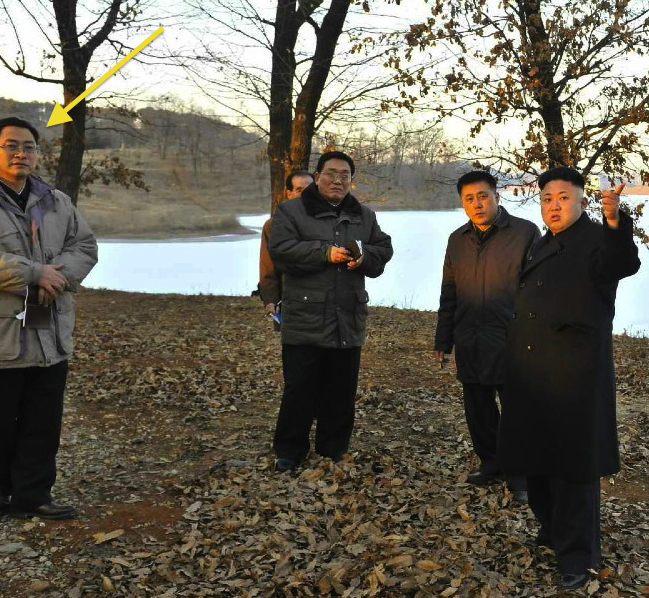
Pak Tae Song attends a KJU visit to a lake near Anju, South P’yo’ngan Province in January 2014. Pak was appointed the party’s regional boss in the province in May (Photo: NK Leadership Watch file photo).
